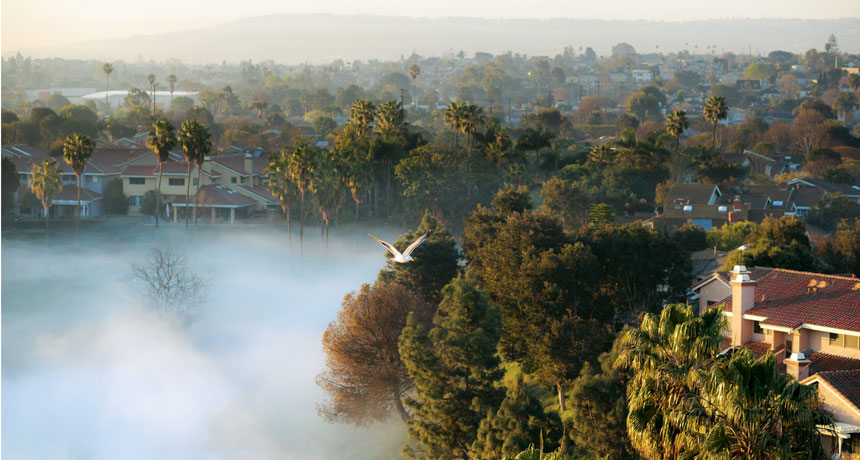Buildings may be chasing L.A.’s fog away
Since 1950, fog frequency in much of Southern California has fallen by more than half

Fog used to grip low-lying areas of Southern California more often than it does today. Scientists now link this drop in fog frequency to urbanization
Angelo DeSantis/Flickr (CC by 2.0)
Heavy low-lying clouds of water — also known as fog — had been a familiar morning sight along much of coastal Southern California. But fog no longer occurs there as often as it used to. The reason? A half-century surge of building has transformed the area into a heat sink, new data indicate.
City planners refer to this building as “urbanization.” The transformation of wildlands into cities and suburban areas brings in lots of brick, concrete and roads. Acting like an energy sponge, these building materials absorb heat by day. At night, they radiate the stored energy back into the air. This boosts late night temperatures. That heat also limits how much water can condense out of the air near ground level to form fog.
A. Park Williams works on climate studies at Columbia University in Palisades, N.Y. Since 1948, fog frequency has plummeted 63 percent in the Los Angeles area. That’s what he and his colleagues will soon report in a paper slated to appear in Geophysical Research Letters. San Diego lies further south, along California’s border with Mexico. There, too, fewer coastal fogs are occurring. But not around Santa Barbara and offshore islands. In these areas, some 177 kilometers (110 miles) to the north, fog rates have changed little. These regions are not as built up as L.A. and San Diego.
Williams and his colleagues used daily weather data collected from 24 airfields. All reside along Southern California’s coast. The scientists also pored over 1950 census data for the area. Then they compared those early population data to modern maps. And a stark trend emerged. Within a 10-kilometer radius of the airfields, they found, urbanization has mushroomed throughout the past 65 years. The change was greatest in those areas where fog became rarest.
Coastal fog is important to the climate of very dry regions, like Southern California. Fog slows the evaporation of water. It also keeps temperatures on the cool side. So decreased fog frequency could worsen California’s drought and lead to hotter summers there, the researchers note. Yet there is one silver lining to the missing clouds: improved traffic safety. Fog is, after all, a major cause of local traffic accidents.
Power Words
(For more about Power Words, click here)
climate The weather conditions prevailing in an area in general or over a long period.
heat sink A material that absorbs heat. Concrete buildings and sidewalks in urban areas are one example.
radiate (in physics) To emit energy in the form of waves.
radius A straight line from the center to the circumference of a circle or sphere.
urban Of or related to cities, especially densely populated ones or regions where lots of traffic and industrial activity occurs. The development or buildup of urban areas is a phenomenon known as urbanization.
weather Conditions in the atmosphere at a localized place and a particular time. It is usually described in terms of particular features, such as air pressure, humidity, moisture, any precipitation (rain, snow or ice), temperature and wind speed. Weather constitutes the actual conditions that occur at any time and place. It’s different from climate, which is a description of the conditions that tend to occur in some general region during a particular month or season.
wildlands Areas where the ground cover (grasses, brush and trees) are not managed, but grow wild. Such areas tend to provide good habitat for animal wildlife.







